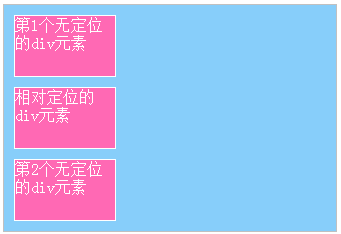在CSS中,我们可以使用“position:relative;”来实现相对定位。所谓的相对定位,指的是该元素的位置是相对于它的原始位置计算而来的。
语法:
position: relative;
top: 像素值;
bottom: 像素值;
left: 像素值;
right: 像素值;
说明:
position:relative;也是结合top、bottom、left和right这4个属性一起使用的,其中,position:relative;使得元素成为相对定位元素,接着使用top、bottom、left和right这4个属性来设置元素相对原始的位置。
top、bottom、left和right这4个属性不一定全部都用到,一般只会用到其中两个。这4个值的参考对象是该元素的原始位置。
注意,在默认情况下,固定定位元素的位置是相对浏览器而言,而相对定位元素的位置是相对于原始位置而言!
举例:
<!DOCTYPE html>
<html>
<head>
<meta charset="utf-8" />
<title></title>
<style type="text/css">
#father
{
margin-top:30px;
margin-left:30px;
border:1px solid silver;
background-color: lightskyblue;
}
#father div
{
width:100px;
height:60px;
margin:10px;
background-color:hotpink;
color:white;
border:1px solid white;
}
#son2
{
/*这里设置son2的定位方式*/
}
</style>
</head>
<body>
<div id="father">
<div id="son1">第1个无定位的div元素</div>
<div id="son2">相对定位的div元素</div>
<div id="son3">第2个无定位的div元素</div>
</div>
</body>
</html>
浏览器预览效果如下图所示。

我们为第2个div元素加入相对定位,CSS代码如下:
#son2
{
position:relative;
top:20px;
left:40px;
}
此时浏览器中效果如下图所示。

分析:
从这个例子可以看出,相对定位元素的top和left是相对于该元素原始位置而言的,这一点跟固定定位是不一样的。
在相对定位中,top、right、bottom、left这4个属性,我们也是只需要其中两个属性就可以确定一个元素的相对位置。
